PRAGUE
October 7–14,
2011
THE BIG PICTURE
Prague was the first leg of our trip through central
Europe to celebrate our 50th wedding anniversary. We flew from Denver
to Boston, enjoyed dinner with
our daughter’s family during our four
hour layover, slept to London,
and got off the plane in Prague.
Our
visit was seven days of happily walking through one of the great cities
of Europe, sampling the city’s art, history, music, architecture, and
foods.
PRAGUE: THE
FIRST 1000 YEARS IN A NUTSHELL
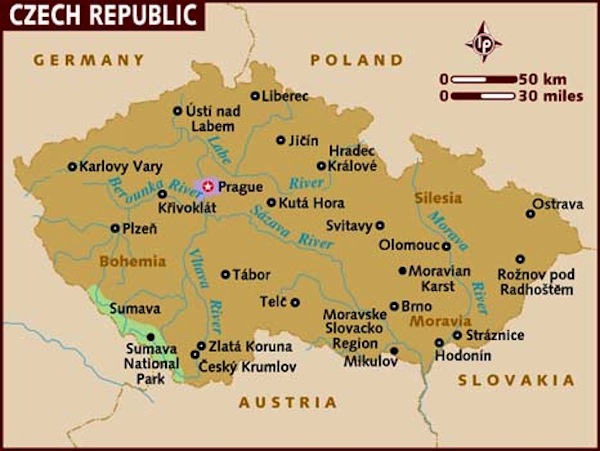
In the beginning were the Celts. Then came the
“Germanic tribes.” The
duchy of Prague was founded somewhere in the 9th
century or before. Then came the Great Moravian Empire, followed by
Bohemian kings, The Holy Roman Empire, and the Habsburgs, putting
Prague under a variety of rulers
through WW I.
The country of Czechoslovakia was created in 1918
when it declared its independence from the Austro-Hungarian Empire
following the end of WW I. With the Munich
Agreement (or, as the Czechs may prefer to call it, the Munich Dictate
or the Munich Betrayal) in
1938, the Nazis took control of Sudentenland
(a large portion of Czechoslovakia) and, between 1939–1945 divided the
country into the Slovak Republic
and the Protectorate of Bohemia and
Moravia. Following WW II it was a Communist ruled country: the Czechoslovakia Republi, the Czechoslovak Socialist Republic,
and the Czechoslovak Federated
Republic and the Slovak
Federated Republic. In 1989 the Communist regime collapsed
during the Velvet
Revolution and Czechoslovakia became independent. Finally in 1993,
Slovakia and the Czech Republic peacefully declared themselves
independent nations with Prague the capital of the Czech Republic and
Bratislava the capital of Slovakia. What a checkered history in 100
years! Throughout all these time, Prague remained the focus of art,
culture, and political power.
Today, Prague is a city of 1.3 million with
another
million in the surrounding metropolitan area. In 1992 parts of the city
were designated a World
Heritage Site (WHS). Despite its large population, the city is
manageable for visitors to explore and appreciate its history, culture,
and beauty as a city. A common complaint from some visitors is that
it is crowded. While it was not during the first week of
October, it is
no wonder that people flock to this magnificent “City
of One Hundred
Spires.” Of all the places we have ever visited, Prague is one of the
most entertaining, diverse, and interesting. We’d happily return again.
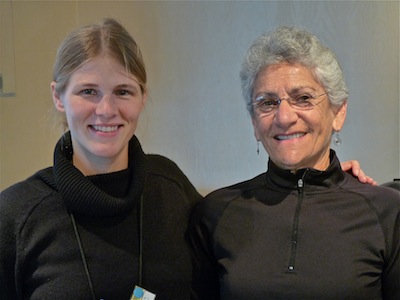
FIRST NIGHT
At our hotel, the Dorint Don
Giovanni, we met with Tereza Libichova, our Grand Circle Travel guide for the
entire trip. She had sent us a letter of introduction a few weeks
before we left so we had some idea of her background: Born and educated
in the Czech Republic, fluid in English as well as Russian, Polish,
Hungarian, and others we are not sure of, studied Russian culture and
literature at the university level, a wife and mother, and, at the age
of 28, knowledgeable about every place we would visit in the
next two weeks. And, we are quick to add, absolutely charming as well.
Prague’s transit system
of trams and subways make it
easy
and affordable to get to all parts of the city. We found that out on
our first night. We had purchased on-line tickets to a concert at
Smetena Hall in the Municipal
House (known better by the locals as Obecni Dum).
This magnificent
Art Nouveau building is an architectural masterpiece, and
Smetena Hall is one of the two great concert halls in Prague and home
to the Czech National Symphony Orchestra.
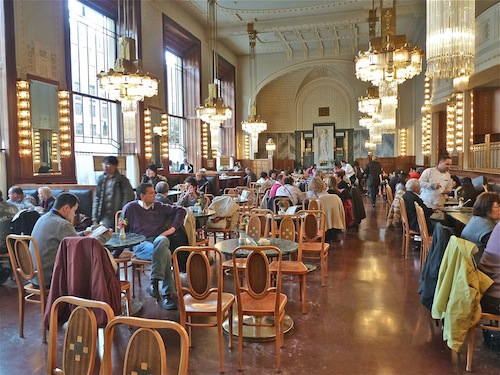
We walked a
few
yards from our hotel to the subway, which was easy to navigate and
reasonably
priced for seniors. We arrived in time to have dinner at the Kavarna
Obecni dum restaurant in the Municipal House, rightly touted as one
of the most beautiful cafes in Europe. Pricey, but it captures the
relaxed feeling of luxury from another time. We felt as though we were
really in a special place, not just at another urban restaurant near
the subway.
The concert was excellent: arias from Puccini and
Strauss, Mozart’s Piano Concerto in A Major (KV
488) and, following the intermission, Dvorak’s Symphony No. 9
(“From the New World”). If the soprano was a bit lackluster, the
pianist
was dazzling, and the New World Symphony was masterfully performed. We
watched from the first level side balcony and the sound was
outstanding. In all, it was a memorable welcome to a city we will
remember forever. Afterwards we walked through the building, noticing
the beautifully rendered tiles, friezes, murals, sculptures, and other
art nouveau decorations throughout. We looked in The
Americky/American Bar, which claims to be the oldest bar in Prague,
though it dates only back to the early 19th century. (Could that really
make it the oldest in town? We are skeptical.) We were to see other
drinking establishments that are indeed much older. We returned to the
hotel about 11:00 exhausted, but looking forward to our time in Prague.
Our general schedule throughout our trip began with
a morning guided tour followed by the afternoon and evening on our own.
The pace was relaxed and we had plenty of time
to select what we might investigate based upon Tereza’s suggestions and
those by Frommer’s and Steves’ excellent guides which we had researched
before leaving.
Prague comprises five historic towns by the River
Vltava: Lesser
Town (Mala Strana),
The
Castle District (Hradcany)
are on the west bank of the Vltava. On the east bank are the Jewish
Quarter (Josefov), Old Town (Stare Mestyo), and New Town (Nove Mestyo, though parts of the
“new” town date back to the 14th century). We were to visit them all,
each interesting in its own right.
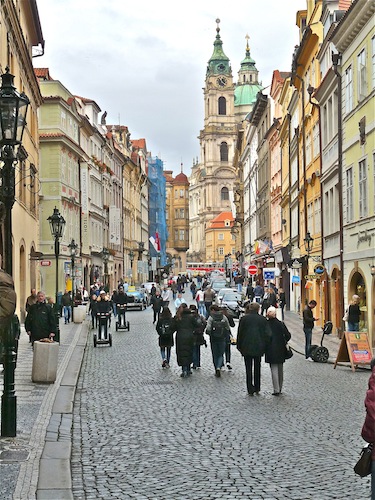
LESSER TOWN
Our tour was of Lesser Town
began with a subway ride and walk to the Wallenstein
Palace Gardens where stand
statues of Greek mythology created by Danish artist Adrian de Vries in
the 15th or 16th centuries until they were stolen by Swedish invaders
in 1648 (and never returned!). What we saw were early 20th century
replicas. Today it is owned by the state and used by many
government agencies. The gardens also featured a wall of
sculpted cement created to give
the appearance of a cave. Peacocks wandered the grounds perhaps to give
it all a feeling of a royalty—or at least privilege. The Wallensteins
were clearly people of great wealth and power.
We walked by the Franz Kafka
Museum to the bank of the Vltava River to note the high water level
from the last great flood in 2002. We noted the area of town on the
other side of the river is protected by a high embankment, but why the
west side was left unprotected is not clear.
We climbed stairs up to the Charles
Bridge, a landmark as iconic—and as busy—as the Rialto Bridge in
Venice or the Ponte Vecchio in Florence, to name just a few. It is a
magnet for tourists, buskers, artists, and families and couples just
strolling. Reconstruction began in 2007 to
shore up the deteriorating stonework, to
return traditional gas lighting, and to lay down a new pavement, all
completed was
completed last year. We walked to the east (toward Old Town) and then
returned to Lesser Town where our tour ended at Saint
Nicholas Church, considered a masterpiece of high Baroque
architecture, that dominates the small Lesser Town Square (Malostranske nam).
As the group broke up, we headed for a cafe that
promised, in good English written on their outdoor chalk board,
Homemade Pastries. We were not disappointed
(in fact, we were never disappointed with the pastries in Prague). In
addition to coffee, Judy
selected from a photo on the menu an incredible ovocny dort s joqurtovym kreme
layered six inches high; Hughes selected a tvarohouy zavin s vanickouyn kreme,
which was equally delicious and as sinfully memorable as Judy’s. And so
it began our visit to Prague.
We walked south from the square down Karmelitska namesti (street) past
the Church
of Our Lady Victorious, home to “the infant of Prague,” a wax
statue of baby Jesus presented to the church in 1628 and which has
gained almost cult-like status. We’ll have to report on that another
time. We were intent on the getting to the top of Petrin Hill not far
away.
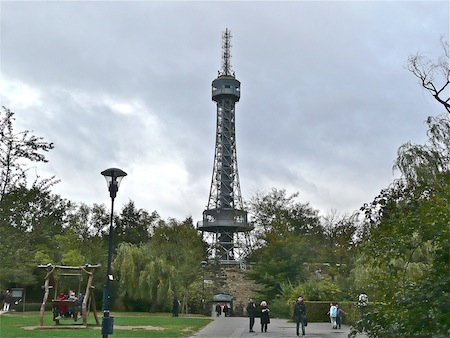
Though we could have walked, we fortuitously chose
to ride the 1600' funicular railway to the top where we discovered the
beautiful Strahov
Monastery, the 800-year-old “Hunger Wall,” (built either to protect
the city from Mongol invaders, or built by famine-starved workers in
return for food; maybe both are correct), and the Petrin
Observation Tower, a one-fifth scale model of the Eiffel Tower that
stands 200' above the hilltop commanding one of the finest views of the
city. It is said that on a clear day you can see the mountains on the
border with Poland, though clear days in Prague are few and far
between. However, while we were there, the clouds parted somewhat
giving us good light and an excellent view of the city and metropolitan
area. And maybe Poland.
We had no idea how many buildings were covered with
red tiles; from the top we learned why Prague is considered the “City
of a Hundred Spires.” We saw the Charles Bridge was completely covered
with folks walking leisurely on this Sunday afternoon. We saw the line
of drab,
anonymous “panel buildings” on the fringe of the city, relics from the
days of Soviet occupation and city planning.
On the way up the hill on the funicular, we talked
with two young fellows, John from Prague and Thor from Reykjavik, who
shared the car with us. They were on a return visit to the top of the
hill and recommended that we have lunch at the charming Nebozizek Restaurant
attached to a small hotel situated halfway down the hill. On our walk
back down, we stopped there and found that the restaurant has a
marvelous view, a great menu, and excellent pastries. They also serve Krusovice Lager,
a favorite among Czechs. We also re-met John and Thor who where also
having lunch.
[Thor
(short for Steinthor) is a professional guide in Iceland and encouraged
us not only to visit but to be sure to contact him for suggestions
about where and how to travel in his country. His pleasant and low-key
personality makes us think he would make an excellent guide. We took
his address, phone, and email (steinthorsigurdarson@yahoo.com) so that
when Icelandic Air opens its direct flight to Reykjavik on May 11,
2012, we will put ourselves in his hands while we’re there.]
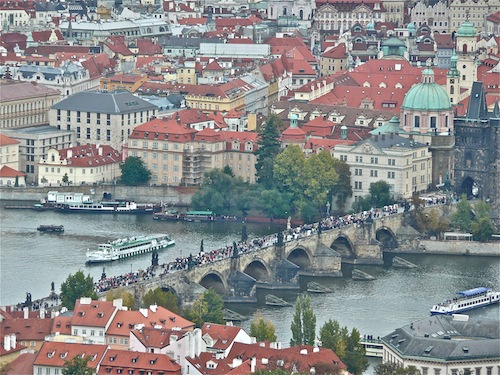
We joined the throng walking across the Charles
Bridge, listened
to some local musicians, looked at the statues, sketch artists, locals
and visitors, and the boats on the river. Strolling through the narrow
cobblestone streets is a pleasure we don’t often have in this country.
[Note:
Unlike other cities in other parts of Europe, Asia, and Latin America,
very few people ride bicycles in Prague. It didn’t take us long to
figure out why: the cobbled streets are crisscrossed with tram tracks,
jarring and unsafe, especially when wet.]
We found ourselves in Old Town Square, a central hub
of what’s happening in the city. Crowds gathered to sip coffee, people
watch, and witness the medieval astronomical
clock, which was not made to tell time but to mark the phases of
the moon, the seasons, and Christian holidays. Today, when the clock
strikes the hour, a brief morality play is presented: the twelve
apostles emerge in a row from the clock while symbols of evil (death,
vanity, greed, etc.) sort of shake and dance below. It may be the most
popular tourist attraction: it’s dramatic, unique, dependable, and free.
As the afternoon wound down, we drifted toward a
often mentioned shopping mall, Lucerna, off
Wenceslas Square. But it was pretty well closed up this Sunday. Back on
the Square, we decided to try some stand-up street food: sausage and
sauerkraut and chicken sandwiches which we washed down with a tall can
of Pilsner Urquell. (We didn’t eat on the street again, and don’t
recommend it.) While we were on the Square we witnessed the removal of
a car illegally parked: a tow truck driver with a hoist strapped the
car to a chain and lifted the car out of the parking slot on the street
and placed it on the back of the flatbed truck. Where it went, no one
could tell us.
THE CASTLE DISTRICT
The Prague
Castle was likely founded over 1,100 years ago in the 9th century
and has always been a work in progress: changes, additions, remodeling,
and reconstruction have occurred almost ceaselessly through modern
times. Architectural styles range from Romanesque to Gothic to Baroque
to Rococo to Neo-Classic. Today Prague Castle, covering over 17 acres,
is considered “the largest ‘coherent’ castle complex in the world.”
Visitors may wander most of the grounds without charge, but there is a
fee to enter the most of the buildings: about $18.75 (half price for
seniors and children). Rick Steves’ guidebook says only four stops
matter, and we saw them all.
1) St. Vitus
Cathedral. Today’s Cathedral,
which towers over the castle grounds and can be seen from all over the
city, is the third incarnation of the church honoring St. Vitus:
the first
was begun in 925, and a second in 1060, was built on the same spot. The
one we visited is the Gothic Cathedral begun in a different place in
1344. By the mid-1500s it was only half finished; lack of funds, wars,
revised plans, new architects, and design-contractor disputes
prevented the completion for nearly 600 years! In 1929, the Cathedral,
the Czech equivalent of Westminster Abbey, was finally finished, though
renovation continues.
In spite of Nazi and Communist occupations, the
interior remains a place of beauty. The organ, which we did not hear,
is magnificent, as are the alter pieces and windows. Of special
interest is the stained window completed by Art Nouveau artist Alfons Mucha.
(There is much Czech history in this window and it would be worthwhile
to read up on how much Mucha depicted in this amazing masterpiece. In
fact, there is probably as much political and cultural history
displayed throughout the Cathedral as there is the usual Biblical
history found in most churches.) A short-tour ticket, which included
other portions of the castle properties, gave us access to additional
areas of the Cathedral and reduced the number of other visitors we had
to contend with. A cathedral is a place to take in slowly, letting the
light and shadows and quiet wash over you. This is not a place to rush
through.
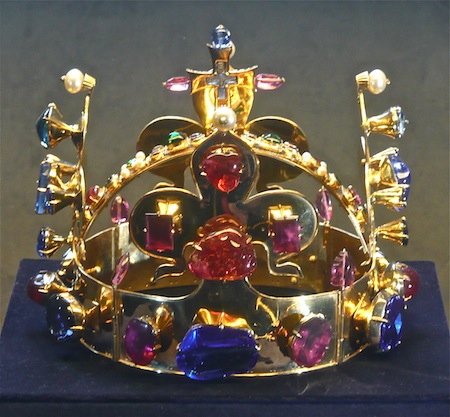
2. Basilica of St. George. This
very old Romanesque building with its wood ceiling shows it age
immediately. It has none of the ornamentation of St. Vitus.
Restoration of the Gothic frescoes is in progress to bring back the
colors to their original condition. It is small, some might say
intimate, but we did not find the majesty of St. Vitus or other
churches we visited on the trip.
3. Royal Palace. This has been the
home of governments and heads of state for over 1,000 years: Bohemian
kings, Holy Roman Emperors, occasional Habsburgs, Presidents of the
Republic—even Nazi big shot Reinhard Heydrich (“Reich Protector of
Bohemia and Moravia”) lived there until he was assassinated. It is said
that Vaclav Havel,
first president of the Czech Republic (1992-2003), chose not to live in
the palace in spite of his right to do so as head of the country.
Like other royal palaces, there are many magnificent
rooms for living, meetings, dining, etc. Here you can view the crown
jewels: the St. Wenceslas Crown, the Royal Apple, the Royal
Sceptre, and the Coronation Cloak. (The crown was so big and gaudy as
to appear fake, but is, in fact, considered priceless monetarily and
historically.) In addition, the palace contains the enormous Vladislav
Hall, large enough to host huge feasts, jousting contests, and large
crowds of guests for coronations and inaugurations without the
impediment of supporting pillars. Also of macabre interest are the
torture room in the dungeon area and also the room where several
defenestrations were accomplished: defenestration is a quaint
punishment whereby politicians or clergy of other notables who had
fallen out of favor were tossed out of an upper story window on one
side of the palace to either their deaths or, in some cases, serious
injury only to be finished off by the mob of observers below.
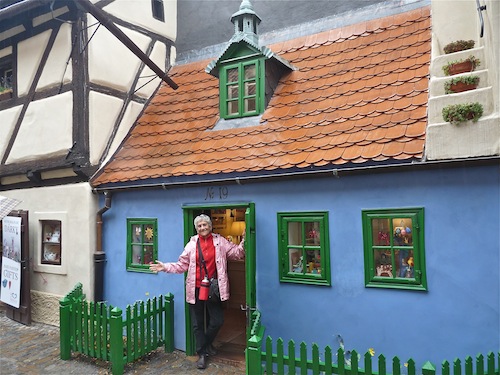
4. Golden Lane. This cluster of
impossibly small buildings (the first rowhouses?) line both sides of a
narrow street leading away from the palace. These tiny dwellings, no
larger than a mid-size travel trailer (without running water or
kitchens), were built by and home to castle guards and to craftsmen for
nearly 500
years. Today, this area has been spruced up as a tourist
attraction with gift shops, some craftsmen, and historical displays. It
is a lively source of retail after a couple of hours of castle touring.
JEWISH QUARTER
Directly across the Vltava River from Lesser Town
and the Castle District and surrounded by Old Town is the Jewish
Quarter, once home to an estimated 15,000 residents. The history of
this section of the city began in the 10th century; Czech Jews were
confined within the walled ghetto as early as 1096. What followed over
the centuries were devastating pogroms, times of prosperity, and a
degree of quasi-municipal administration; there was even a period of
emancipation when, in the late 1700s, Joseph II, the Holy Roman
Emperor,
enacted the Toleration Edict, allowing Czech Jews to settle outside of
the Jewish Quarter. Many left and the ghetto slowly became a slum
providing shelter to mainly the poor. Many of the buildings were
demolished in an urban renewal project just prior to WW I, leaving
today only six synagogues, the cemetery, and the Jewish Town Hall.
Rather than completely destroy the remains of the ghetto, during the
Nazi occupation of Prague, Hitler removed most of the Jews
to death camps; he planned to preserve the area as a museum to an
“extinct race,” displaying artifacts from across Europe as he expanded
his vision of the Third Reich.
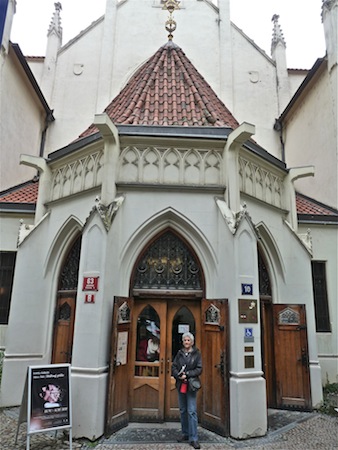
Many of the buildings and apartment houses within
the Jewish Quarter have been built since 1900 (and in art nouveau
style) and give the area an upscale look. Exploring the older sections
and buildings can be accomplished with the aid of a good city map; to
really see what the Jewish Quarter is like, we purchased a ticket to
visit the Jewish
Museum of Prague, which permits entry to four of the
synagogues (a separate ticket is required for entry into the Old New
Synagogue) plus the Old Jewish Cemetery and the Ceremonial Hall.
It is quite worth the 300 Czech korunas (about $16)
per person to walk the self-guided route. A few more dollars for an
English language recorded guide was very helpful. The size and detail
of each synagogue varied from small and simple (like the Maisel
Synagogue pictured here) to the extravagant
Spanish Synagogue, built in the 19th century in the style of the Moors,
which
stands out for its size and its artistic excellence—and its organ.
However, a walk through the Old Jewish Cemetery
was most moving experience as
well as reading the materials in the Old Town Hall. Here we were in the
presence of some 12,000 tombstones, most illegible from deterioration
and erosion of the lettering (but we don’t read Hebrew anyway), dating
from the middle 15th century to 1787, each representing the resting
place of a dozen or more individuals layered in the ground one atop of
the other because there was so little space available (since Jews could
not be buried outside the Jewish Quarter).
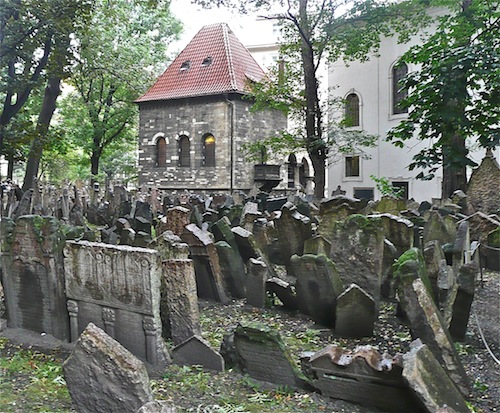
[The
New Jewish Cemetery was founded in 1891 and is
located a few miles outside of the downtown area, actually quite close
to our hotel. It has an area for 100,000 graves and includes a memorial
to Czech Jews who died in concentration camps or killed in the
resistance movement. The most visited grave is probably that of Franz
Kafka.]
We planned an entire morning to explore this part of
Prague, and we could have extended it for the whole day. There is much
to see and much to grasp, to try to comprehend. In the end, we had to
break away—at least a little ways off. On a side street still within
the ghetto walls we found the Golem Cafe
that offered excellent
strudel and pastries, hot coffees—and the golem! At least a model of
the famous Golem of Prague, whose legend in known to most Jewish
children today—and many gentiles as well since David Wisniewski’s
creative and colorful Golem (Houghton
Mifflin, 1996) won the 1997
Caldecott Award; it can be found virtually all libraries throughout the
country. It’s not clear how or why this six-foot statue stands inside
the cafe, or if it draws many customers, or if it’s there for
safekeeping. However, we enjoyed the connection and the pastries.
To shake the mood and let our emotions subside, we
took our bread and cheese from the hotel buffet and walked through the
drizzle to a park on the banks of the Vltava near the Rudolfium, home
to the Czech Philharmonic Orchestra, to “picnic” under a leafy tree and
watch folks on the river or crossing the Manesuv most, the bridge just
north of the Charles Bridge.
We wandered again through Old Town Square,
watched
the Astronomical Clock “chime,” found a source of outstanding
pastries—maybe the best of the trip—at the Patisserie
Saint Tropez within the Lucerna
Shopping Mall. Good coffee, too.
We enjoyed an authentic pub dinner in Old Town with
David and Caroline Voorhees, fellow travelers whom we found very
compatible and easy to
be with. David enjoys good food and some beer to wash it
down. Caroline and Judy got along well and the four of us had the first
of several evenings together on the trip. David somehow found the
Restaurace and Hotel U Medvidku,
which dates back to
1466. In the back of the pub is the “smallest brewery in Prague” that
makes the strongest beer in the world, X Beer 33
with an alcohol
content of 11.8% The subterranean beerhouse seats 300 and was
appropriately smoky, noisy with loud talk and a hockey game on the big
screen TV, and a menu of traditional Czech fare. For the first time in
Prague, we enjoyed Budvar, the original Budweiser, a fine tasting
pilsner made at the pub. We’ll come back another time for the X Beer
33. Walking to
and from the subway at night did not cause us any concerns. We might
not feel the same way in a large US city at night.
OLD TOWN, NEW
TOWN, AND AROUND TOWN
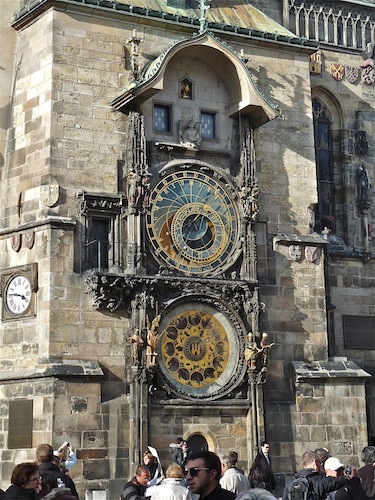
We often find we enjoy wandering around a city
like
Prague, not lost (we learned in Venice to keep a map handy) but without
a specific destination when we start out. We probably miss things we
“should see,” but we often stumble upon treats not mentioned in the
guide books.
Old Town Square is Prague’s impressive center of
history
and culture—and crowds! Though we don’t know for sure, we
suspect dozens of pockets are picked there every day. Old Town Square
was a traditional market square for a thousand years. Today it is the
gathering place for outdoor cafes and restaurants, meeting people, and
watching the Astronomical Clock “chime” the hours. Here are statues to
such national heroes as Jan Hus, grand churches like the Church of St.
Nicholas and Tyn Church, art museums, the Old Town Hall, carriage
rides, and countless
places selling gee-gaws to tourists.
We passed through the square several times on our
strolls of the city, but never met anyone we knew, found quieter places
for coffees and pastries or, in the evenings, restaurants and pubs in
other parts of the city, and never found a gee-gaw that captured our
fancies.
We did find the “Fred and Ginger
Building,” or
“Dancing House,” a controversial modern office building, erected on the
spot where an allied bomb was dropped by accident during WW II (the
pilot thought he was over Dresden!) that gives the
appearance of two people dancing. It was worth a glance, but we’re glad
we didn’t plan our day around locating it.
On the way, however, we passed a display of police
and fire department vehicles and equipment that was being set up for
some sort of public exhibition and demonstrations. Judy found the
vehicles and equipment very much like what we have in this country and
couldn’t resist being photographed with some of the trucks. We could
not find anyone who could or would trade a Prague Fire Department patch
for one of ours from Nederland.

Part of several days, usually in the afternoon, Judy
found time to run in the neighborhood of our hotel. In spite of wet
pavement, a chance of drizzle, and running in unfamiliar areas, she
tried her best to keep to her schedule. All this after 3–4 miles of
walking most days.
The dividing line between Old Town and New Town is
somewhat blurred; we never could quite figure where one stopped and the
other began. However, when you’re in the heart of New Town, you sense a
“where it’s happening” feeling by what people are wearing, how fast
they walk, and what shops line Wenceslas Square (not really a square
but rather a wide, three block patch of boulevard dominated by
pedestrians). At one end is the National
Museum (closed while we were
there for repairs and renovation), a huge 19th century building that
still shows the scars of Communist gunfire during the 1968 Spring
Uprising. An interesting statue of St. Wenceslas stands in front, a
monument to this symbol of Czech nationalism. The other end the
boulevard is a cross street to the right of upscale, modern stores and
such Art Nouveau landmarks as the Mucha Museum
and the Municipal
House.
Look for the black Powder Tower, built to house the city’s supply of
gunpowder, standing guard over this area.
For us, this was a refreshing look at modern Prague
and those who live there.
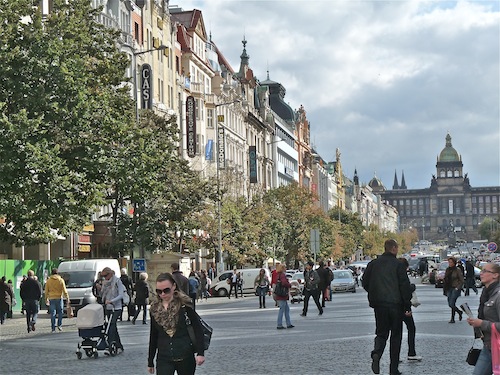
[Note:
People watching in the area of Wenceslas
Square, as well as throughout the city, was very entertaining. In most
ways, the Czechs are very like Americans: they dress like us, they wear
their hair as we do, they act in every way like Americans. We did note
that the younger women tend to be noticeably tall; in many cases of
couples on the street, the women were taller than the men. The younger
women also had noticeably skinny legs in their very tight jeans. We
also saw very few dogs, and those we did see were off leash though
clearly “with” their owners. No cats in sight.]
We watched an illegally parked car be lifted onto
the back of a
flatbed truck and taken who knows where; we spent a relaxing and
revealing hour at the Mucha Museum
learning to appreciate the full
range of this artist’s patriotic genius (as well as beautiful designs
and colors); well worth the modest price of admission. We skipped the
MacDonald’s and Starbucks which we suppose were bound to happen in a
city this big. We also skipped the highly recommended Museum of
Communism, which seemed to us out of place in this strongly
anti-Communist country (though for a country that is generally
non-religious, there are scads of churches).
But we do remember we ate
very well while in Prague:
To the cafe on
Lesser
Town Square whose name, regretably, we did not write
down: You have not been forgotten. We will easily find you
in a heartbeat when we return—opposite St. Nicholas Church. Your
pastries
were wonderful! We did, however, write down the the following cafes and
restaurants we also enjoyed:
•Nebozizek Restaurant on the
side of Petrin Hill
(below, and mentioned earlier).
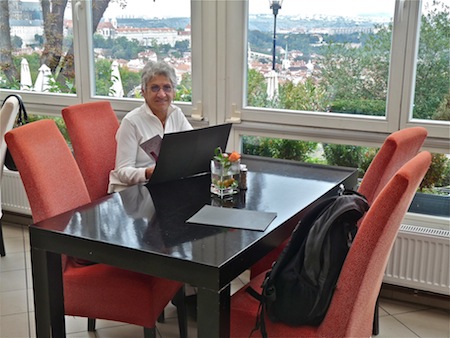
•Restaurace
and Hotel U Medvidku
(in Old Town, mentioned earlier)
•Patisserie
St. Tropez (in Lucerna Mall, mentioned earlier).
•U
Vejvodu Restaurant. David did it again! This
famous “Old Bohemian Alehouse” seems to be another pub popular with
locals and visitors alike. The menu featured traditional Czech cuisine
including potato soup and a delicious roast duckling which Judy and I
split. I don’t know how David found these two places, but his choices
were excellent. Thanks, David. Come west and we’ll return the favor.
•Grand
Cafe Slavia. Just across from the National
Theater, this spacious coffee house has been the meeting place of
artists, writers, actors, and political dissidents (and at least one US
president: Bill Clinton). In fact, the story goes that in the period
leading up to the 1989 Velvet Revolution, at any given time, half the
customers at the Slavia were political dissidents and the other half
Communist secret service agents. Whatever the truth, the Slavia’s
coffees and pastries were among the finest we had on the entire trip,
the service was impeccable, and the views of the river and castle
outstanding.
•Lehka Hlava. Tucked
away on a tiny backstreet just a
few blocks south of the Charles Bridge in Old Town is a small
restaurant that serves singularly non-traditional food. One of probably
a tiny handful of vegetarian eating establishments, Lehka Hlava offers
an eclectic menu from around the world featuring greens, fresh ginger
tea, and main dishes strong on lentils, veggies, tofu, cheeses, etc. It
also may be one of the very few places in Prague that bans smoking!
Dinner was a tasty change of pace from the carnivorous dining in smoky
basements we had been used to.
In addition to wandering the streets of Prague, we
visited two World Heritage Sites out of town:
SIDE TRIP: KUTNA
HORA
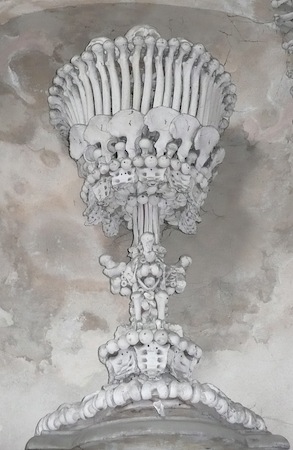
About 40 miles east of Prague, Kutna
Hora was once a
thriving and wealthy silver mining town of where much of the coins of
central Europe were minted from silver mined in this area. The mines
petered out by 1700 and Kutna Hora, like mining towns everywhere,
including in the western USA, slumbered. Went ghost. Today it is what
the guide books call a “refreshingly authentic” town, and tourists have
discovered its charms, which include the beautiful 14th century Saint
Barbara Cathedral and the macabre decorations of the Sedlec
Bone
Church just a mile away.
Imagine the number of deaths from the plague
and
wars that spread across central Europe in the 1300s and 1400s. Bones of
the dead were often piled in churches as a reminder to the living of
the mortality of us all. Sometimes it was just a matter of practicality
and convenience. Such places were called ossuaries and can be found
among both Christian and Jewish communities throughout Europe.
The Sedlec Church is the final resting place of over
40,000 souls whose bones languished in disarray until the monks decided
to creatively display the bones in designs that were as elaborate as
they were imaginative. The result is a display of human bones that is
decorative: a breastplate and shield can be seen, sculptures, and
artfully arranged skulls. What struck us was the chandelier that in
comprised of every bone in the human body. While the first impression
may be one of horror, we left with respect for the ingenuity of the
artist-monks who completed the works.
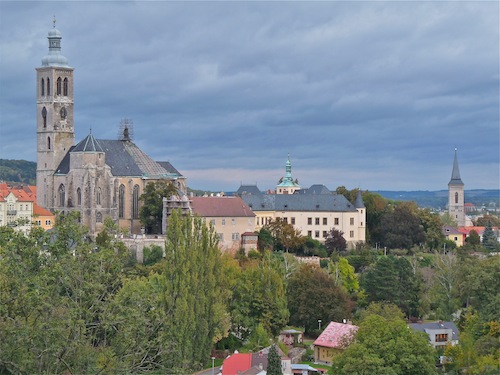
Saint Barbara is the patron of miners who
founded
the cathedral (some claim it is not a cathedral but “only”
a church) in 1388 and generally represents Renaissance and Gothic
styles. The frescos and windows are of high quality and the interior
is, overall, stunning. Just across from the cathedral is a long
dormitory erected by the Jesuits for their college in the 1600s. There
are statues along the promenade next to the building that are patterned
after the statues found along the Charles Bridge in Prague.
We walked through the quiet narrow cobblestone
streets, looking at store windows, enjoying the
near-absence of traffic and the contrasting pastels of the buildings.
In fact, the whole day gave us a rest from the rush and bustle of the
city. We found a very out of the way pub/cafe where Hughes ordered ribs
(and potato pancakes) and was served eight racks of ribs, absolutely
delicious and more than he cold handle (but enough to share with
another of the folks with whom we ate). Of course, there was beer to
help wash down the good food. There is always beer in the Czech
Republic!
[Postcards
sent from Kutna Hora were received within
a week of posting them. It may be because they were sent from a post
office and Hughes witnessed them being hand stamped.]
SIDE TRIP: CESKY KRUMLOV
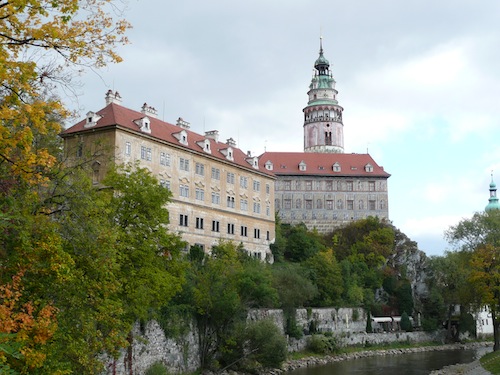
This medieval town of 15,000 was our last stop
in
the Czech Republic before we reached the Danube. Celts first settled
here before the time of Christ, then came Germanic tribes, and finally
the Slavs in the 9th century when it became an important part of
Bohemia. It flourished as a cultural center and the site of an
important Jesuit college. The Habsburgs “bought” the region in 1602 and
it became an important German city until 1945 when most Germans were
expelled.
What has survived is a town of great beauty and
architectural diversity: Gothic, Renaissance, and Baroque buildings
with charming facades, frescoes, and stonework. It has the appearance
of a fairy tale town and tourists have discovered the town which has
prospered with the influx of visitors. It claims to be the second-most
visited town in the Czech Republic and was named the country’s first
World Heritage Site in 1992.
Cesky Krumlov
was a stop between Prague and Linz
(Austria) where we would board the ship that afternoon for our cruise
down the Danube.
We stopped for a home cooked meal at Pension
Jana, a small hotel/bed and breakfast
run by a cheerful and outgoing woman who, with the assistance of her
mother and her mother-in-law, prepared a lunch of potato soup,
delicious and filling roasted chicken and veggies, with strudels and
coffee for dessert. It was a very pleasant stop with a chance to see
the home of middle class family.
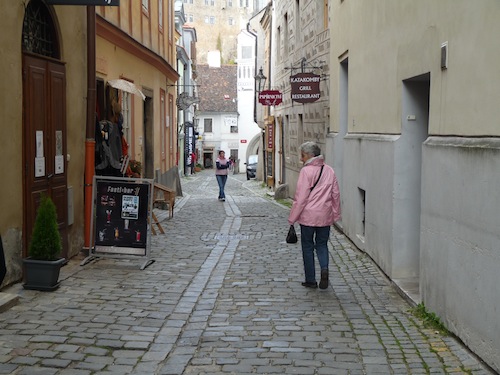
Jana’s home was in a tidy neighbor hood
overlooking
the old town center. We had a brief guided tour to point out Krumlov
Castle (access to the interior requires a tour ticket), the colorful
Round Tower (site of the first castle) with its painted exterior
frescoes now restored, the Church of St. Vitus, and, as could be found
in so many central European towns, the monument to plague victims. We
did not have time to visit the bear pits, the puppet museum, or the
Baroque Theater, one of the few remaining in Europe where dramas and
comedies were once performed.
Wandering along the cobblestone streets, we were
mindful that Cesky Krumlov was part of Sudetenland, the predominately
German areas of Czechoslovakia. The Munich Agreement in 1938 ceded this
area to Germany and the Czech minority was forced to leave. At the end
of WW II 3,000,000 people of German ancestry were forced out of their
homes in Czechoslovakia; Cesky Krumlov lost over three quarters of its
population and Czechs moved into the abandoned houses. In time the town
reclaimed its charm with the support of the Czech government and Cesky
Krumlov has again flourished.
A FINAL
OBSERVATION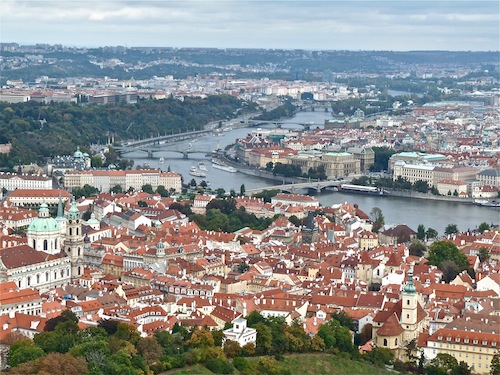
Our preconceptions of Prague as a gray,
sprawling,
drab city with industrial smog and fumes hanging over decaying
buildings has been completely replaced by images of grand gothic and
baroque churches, elaborate palaces, a rich variety of art, inviting
cobblestone streets in quiet urban neighborhoods, a city that
comfortably blends the modern with the Middle Ages. It is an area of
great beauty and an atmosphere that beckons visitors to explore the
details of a great city that has endured a thousand years as a cultural
and political crossroads. We are so glad we came and that we chose to
spend as much time here as we did.





